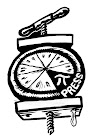Imagining A Middle Class Does Not Create One (October 12, 2010)
Surveys show that Americans wildly underestimate the concentration of wealth in America. This disconnect between perception and reality shows the power of propaganda
Americans have been trained to believe that membership in the "middle class" is their birthright if they "work hard" in the status quo.
What income defines "middle class" is a function of locale and prevailing wages/costs ($100,000 in Manhattan or San Francisco isn't much because costs are so high), but in terms of purchasing power we can probably agree that middle class membership includes:
1. reliable private transport
2. a home with meaningful equity
3. healthcare insurance/coverage
4. a retirement fund of some sort
5. a college education/higher education or training
How many people "own" all of the above minimum standards has been drastically reduced by various factors.
Another measure of "middle class" is even simpler: a middle class household owns some wealth. It could be a retirement fund, a free-and-clear home, a business, income property or gold/cash/investments.
By that measure, the middle class comprises at best 20% of the populace.
Check out his charts to see how the numbers really add up.
The basic truth is that working folk have been gradually underpaid for thirty years, and now the chickens have come home to roost. Corporations have built their wealth on the backs of their employees by using money that should have gone to their workers for profits for themselves. And the end result is that there are no consumers left who can afford to consume - in a consumer (not a producer or manufacturing) society. The demise and disrespect of unions has kept the playing field vastly unequal, which is against the classic definition of a 'free market' (mythical though it may be.) In this classic definition, there is supposed to be a balance of powers to make it work, between the company, the employee/worker, and the consumer - much like the 'separation of powers' in the American system of government, designed to keep any one component from dominating the others.
This is not the case today, and the myth of the 'trickle-down' theory, which has been given a 30-year shot, has proven devastatingly wrong. Read Smith's article to see how things have really panned out due to 30 years of conservative economic theory.







0 Yorumlar